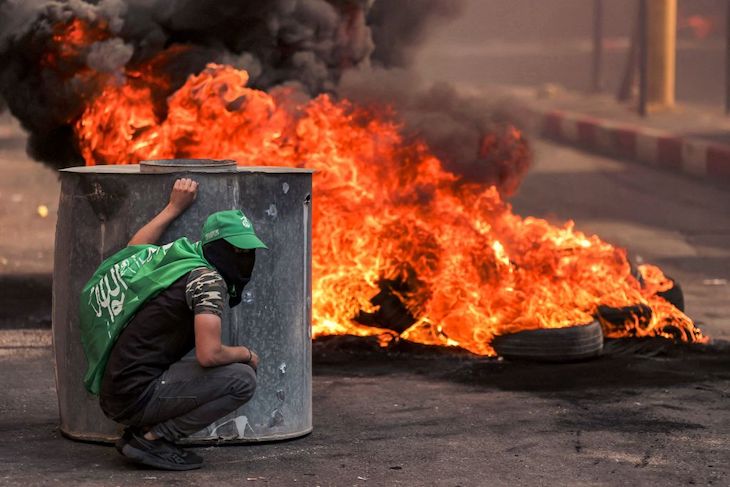As Israel releases body cam footage showing the stark reality of Hamas terrorists’ brutal attacks on civilians during their assault on 7 October – and as its forces begin launching limited raids into Gaza to prepare the ground for a full-scale offensive by land, sea and air – the severity of Hamas’s situation is finally dawning on its militants. The mood amongst its members in the labyrinthine tunnels beneath Gaza is likely to have darkened dramatically.
Despite Hamas’s delusional boasting of bravely fighting to the death and ‘saving Palestine’, the penny is beginning to drop that these are the final days, both for the terrorists, and for Hamas as an organisation. Whenever Israel launches its onslaught, Hamas has already made the mistake common amongst extremist movements which resort to terrorism to achieve their objectives: they eventually do something so horrendous they destroy themselves.
Hamas has already made the mistake common amongst extremist movements
The provisional Irish Republican Army (IRA) learned this the hard way following their Remembrance Day bombing at Enniskillen in Northern Ireland in 1987. The attack, which killed 11 and injured more than 60 (many of them elderly) while they stood in silence to pay their respects to those who had died during both World Wars, became the centre of world attention, dominating both national and international headlines. It attracted condemnation from across the religious and political spectrum, bridging the Protestant and Catholic divide in horror at its depravity.
The ‘desecration’, as prime minister Margaret Thatcher described it at the time, undermined the support base upon which the IRA relied – not just in terms of funding, but the emotional and psychological support that the small, secretive group needed to sustain its operations.
It would prove to be the beginning of the end for the IRA movement. Counter-terrorism efforts to thwart it were galvanised, with Britain and Ireland passing the 1987 Extradition Act the following month, making it easier to send IRA suspects from the Republic to Britain. Libya, the IRA’s most important supplier of weapons and explosives, came in for international condemnation after the bomb was found to be Libyan Semtex. Its support would eventually dry up. Backing for the Republican campaign was devastated and the drive towards a political solution to the conflict was revitalised. This ultimately paved the way for the Northern Ireland peace process, with the United States chairing peace talks under its Special Envoy Senator George Mitchell throughout the 1990s.
The parallels with the Gaza situation are striking, with Hamas’s network of defenders steadily evaporating in the region and internationally. As Jake Wallis Simons wrote in The Spectator, the Arab world has turned against Hamas. Polling data shows a general ebbing away of support even prior to the 7 October atrocity, with those approving of Hamas down to as little as 10 per cent in some Gulf countries. The shellacking that the visibly shocked former Hamas leader, Khaled Mashal, took in an interview on Saudi Arabia’s main TV channel – where he faced a relentless interrogation of Hamas’s actions – is a clear sign that, behind the seemingly obligatory official statements of solidarity with the Palestinian cause, patience with Hamas’s savagery and intransigence has now completely run out.
As with Enniskillen, the 7 October attack has prompted renewed strategic focus on counter-terrorism measures. French president Emmanuel Macron has proposed an international coalition against Hamas similar to that which took down Isis. Meanwhile, Israel has started the complete revitalisation of its security apparatus, mobilised 360,000 reserve soldiers from around the world, and, most importantly, has unified around a common objective: destroying Hamas.
This contrasts sharply with an increasingly divided Hamas. The tension between its hardliners and those who wish to de-escalate can be seen in its schizophrenic policy on the release of hostages, with some in favour of releasing the sick, elderly, women and children on humanitarian grounds, while others are resisting letting anyone go unless all Palestinian prisoners in Israel are set free.
Such Hamas diehards are highly likely to purge themselves by attacking Israeli ground forces during the upcoming incursion – a bid, in their minds, to go out in a blaze of glory. In reality, they will leave behind a decimated organisation less able or willing to keep in check the reportedly growing resentment towards its rule amongst ordinary Gazans. In such circumstances, it’s not hard to imagine a negotiated settlement where Israel has restored a sense of deterrence, and where a chastened, diminished Hamas governs via a power sharing agreement with the Palestinian Authority – which, even prior to the recent terrorist attacks, an overwhelming number of Gazans wanted to take over governance.
There is no shortage of candidates to play the mediator role that the US fulfilled in Northern Ireland, with both Norway and Qatar having the expertise, the contacts and the trust of both sides necessary to chair what will be extremely protracted and difficult peace talks. The hardest part will be finding the Palestinian equivalent of Martin McGuinness or Gerry Adams, those willing to set aside the old enmities in search of progress.
Just like during The Troubles, it can be difficult to recognise a turning point in a conflict that has spanned decades, but we may already have reached it. When the dust settles in Gaza, whatever is left of Hamas can either choose to finally get with the programme and morph into a moderate political force, or try to continue with their barbarism and be annihilated. Either way, its days as an organisation prosecuting terrorism and violence against civilians are numbered. The region and the world have had enough.






Comments